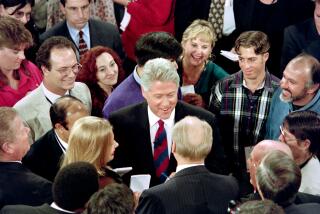A Briefing Book on Clinton’s Campaign
- Share via
Here’s how Bill Clinton plans to win the presidential election this November:
Step 1: Raise more than $20 million and scare any other potential Democratic candidate out of the race.
Step 2: Steal some of the Republicans’ most popular positions, like a balanced budget and traditional social values.
Step 3: Hold tight to a couple of still-popular Democratic positions, like support for increased Medicare funding and tough environmental regulations. Castigate Republicans who disagree as “extremists.”
Step 4: Reappoint Alan Greenspan as chairman of the Federal Reserve Board to reduce the chance of a hiccup in the financial markets. Keep the economy purring until November.
Step 5: Campaign like crazy in California plus a strategic triangle of states in the Midwest and East: Illinois, Michigan, Ohio, Pennsylvania, New Jersey and New York.
Step 6: Pray for a divisive and bitter Republican primary race, a peaceful summer in Bosnia--and no new Whitewater revelations.
Here’s what Bill Clinton must do to win a majority:
Clinton may be ahead in the national polls’ matchups with Republican challengers like Kansas Sen. Bob Dole, Texas Sen. Phil Gramm or publisher Steve Forbes, but the arithmetic of the electoral college still guarantees a tough race.
The president begins with a handicap: He’s unlikely to win any states in the increasingly-Republican south. That puts as many as 151 electoral votes, more than 25% of the total of 538, out of reach. That means Clinton must amass his majority of 270 electoral votes in other parts of the country, beginning with California (54 votes, 20% fifth of a winning majority), New York (33), Pennsylvania (23), Illinois (22), Ohio (21) and Michigan (18). Those won’t be easy states to win; in 1992, Clinton took only 40% of the vote in Ohio--just enough to win in a three-candidate race.
Clinton’s 1996 race will look different from his 1992 run against Republican George Bush. “An incumbent’s race is different from a challenger’s,” observes Ann F. Lewis, the day-to-day director of the still-forming Clinton-Gore campaign organization.
For one thing, the president will be defending his record and extolling the health of the nation’s economy--instead of complaining about the number of people out of work.
For another, Clinton concluded that one reason his Democrats lost control of Congress in 1994 was the Republicans’ success in painting them as indifferent to voters’ concerns about declining social values.
And instead of proposing new federal programs like universal health insurance, Clinton will be running on his record as a budget-cutter who eliminated 200,000 government jobs. “The era of big government is over,” he declared in his State of the Union address in January.
Here’s who Bill Clinton is counting on to help him win in November:
Instead of the insurgent populist James Carville, who directed the strategy of the 1992 campaign, Clinton has assembled a team of steely tacticians for this year’s run. Chief among them is Dick Morris, the chameleon consultant who first worked for Clinton, then the young attorney general of Arkansas, in 1977. Morris later worked for for conservative Republicans like North Carolina Sen. Jesse Helms and Mississippi Sen. Trent Lott before returning to Clinton’s side.
Morris is the only figure outside the White House on the seven-person “board of directors” that is providing overall direction for the campaign. The others are Clinton, his wife Hillary, Vice President Al Gore, chief of staff Leon Panetta, deputy chief of staff Harold Ickes and counselor George Stephanopoulos.
An outer circle of advisors includes veteran liberal organizer Lewis, Connecticut Sen. Christopher Dodd, Democratic National Committee chairman Don Fowler, Commerce Secretary Ron Brown and Housing and Urban Development Secretary Henry Cisneros.
Paid consultants include veteran Democratic media strategist Bob Squier, New York pollster Mark Penn of the Penn/Schoen firm, Memphis video producer Marius Penczner and hard-boiled New York radio and television consultant Hank Sheinkopf.
Sheinkopf has often cast himself as an advocate of attack advertising; he has been widely quoted as saying: “I subscribe to terror.” He ran a 1987 media campaign that helped sink the Supreme Court nomination of Judge Robert H. Bork and has worked on initiative campaigns in California.
Among Clinton’s 1992 strategists, Carville is still frequently consulted by the president but has no formal role in this year’s campaign. Stanley Greenberg, the chief pollster in 1992, fell out of favor after the 1994 congressional-election debacle and has been relegated to a lesser role. Paul Begala, Carville’s lieutenant, was banished by the Clintons after he publicly criticized the president for moving so far to the right.
Until this month, Clinton campaigned mostly by staying in Washington and slugging it out with the GOP in the battle over the federal budget--a strategy his press secretary, Mike McCurry, dubbed “modified Rose Garden.” But the president is beginning to travel to primary and caucus states like New Hampshire and Iowa--to grab some free media attention and provide a counterpoint to the Republicans’ nomination struggle.
More to Read
Get the L.A. Times Politics newsletter
Deeply reported insights into legislation, politics and policy from Sacramento, Washington and beyond. In your inbox twice per week.
You may occasionally receive promotional content from the Los Angeles Times.










